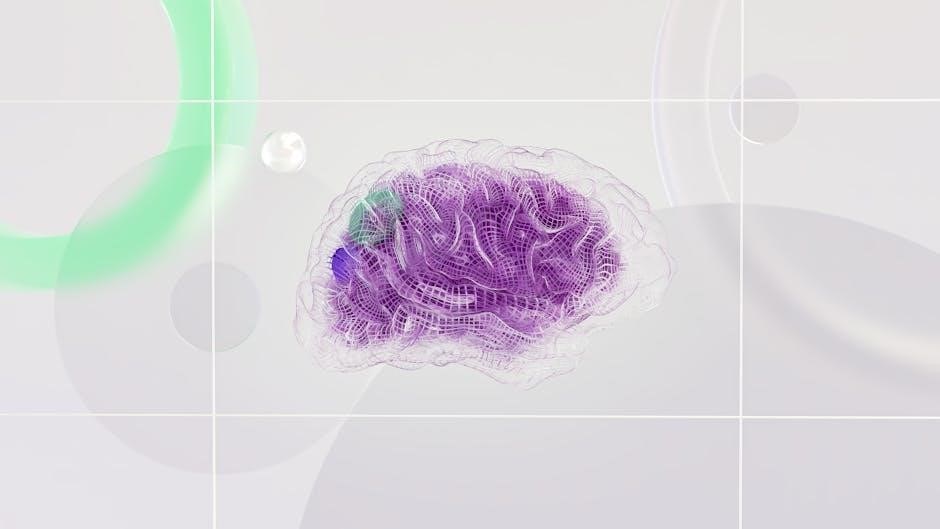Xnxn Matrix Matlab Plot PDF: An Article Plan
This article aims to offer a comprehensive guide to plotting Xnxn matrices within MATLAB, culminating in exporting plots to PDF. The plan covers fundamental plotting techniques, advanced visualization methods, and practical applications. It also includes plot customization and toolbox utilization.
In MATLAB, an Xnxn matrix represents a square matrix, where the number of rows (Xn) equals the number of columns (Xn). These matrices are fundamental in various mathematical and computational applications, including linear algebra, image processing, and data analysis. MATLAB provides powerful tools for creating, manipulating, and visualizing these matrices.
Understanding the properties of Xnxn matrices is crucial for effective use in MATLAB. These matrices can be composed of real or complex numbers and can represent diverse data sets or mathematical models. MATLAB’s intuitive syntax and extensive library of functions make it ideal for working with matrices of any size, facilitating complex calculations and analyses.
Furthermore, visualizing Xnxn matrices in MATLAB enhances understanding and interpretation of the data they contain. Various plotting functions, such as `imagesc`, `surf`, and `plotmatrix`, enable users to represent matrix elements graphically, revealing patterns, relationships, and trends within the data. This visual representation is essential for identifying key features and making informed decisions based on the matrix data.
Basic Plotting Functions in MATLAB for Matrices
MATLAB offers several fundamental functions for visualizing matrices, providing a foundation for more advanced plotting techniques. The `plot` function, while primarily designed for plotting vectors, can be adapted to display matrix data by plotting columns or rows against each other. This is useful for visualizing relationships between different variables represented in the matrix.

Another essential function is `plotmatrix`, which creates a matrix of scatter plots, displaying the relationship between each pair of columns in a matrix. Diagonal elements show histograms of each column, offering insights into data distribution. This function is particularly useful for exploratory data analysis and identifying correlations between variables.
For creating 3D surface plots, the `surf` function is invaluable. It requires creating a meshgrid using the `meshgrid` function to define the x and y coordinates. The matrix values then represent the z-coordinates, creating a surface that visualizes the data in three dimensions. These basic functions provide a starting point for effectively representing and analyzing matrix data in MATLAB.
Visualizing Matrices with `imagesc`
The `imagesc` function in MATLAB provides a straightforward and effective way to visualize matrices as images. It interprets matrix elements as color data, creating a visual representation where each element’s value corresponds to a specific color. This is particularly useful for understanding the overall structure and patterns within a matrix.
One of the key features of `imagesc` is its ability to automatically scale the color data to the full range of the colormap. This ensures that the entire spectrum of colors is used, enhancing the contrast and visibility of subtle variations in the matrix. Without scaling, the image might appear washed out or lack detail.
The function is simple to use; just pass the matrix as an argument: `imagesc(A)`. Customization options include specifying a custom colormap using `colormap`, adding a colorbar for interpreting the color scale with `colorbar`, and adjusting the axes labels for clarity. `imagesc` is a powerful tool for quickly gaining insights into matrix data.
Creating 3D Surface Plots with `surf`
The `surf` function in MATLAB allows you to create 3D surface plots from matrices, providing a powerful way to visualize data with a spatial dimension. This function is particularly useful for representing data where the value at each point can be interpreted as a height or intensity.
To use `surf`, you typically need to provide three matrices: X, Y, and Z. The X and Y matrices define the coordinates of the points on the surface, while the Z matrix represents the height or value at each of those points. Often, the `meshgrid` function is used to generate the X and Y matrices from vectors representing the x and y coordinates.

The basic syntax is `surf(X, Y, Z)`. You can customize the appearance of the surface plot by specifying colormaps, lighting effects, and viewing angles. The `colormap` function controls the color scheme, while functions like `shading interp` can smooth the surface appearance. The `view` function allows you to adjust the camera angle for optimal visualization. This is an effective method to plot a 3D surface of a matrix A, with x and y values on the axes and z values representing height.
Using `meshgrid` for Coordinate Grids

The `meshgrid` function in MATLAB is essential for creating coordinate grids, particularly when generating 3D plots or visualizing matrix data as surfaces. It transforms the domain specified by two vectors into two matrices, which can then be used to evaluate functions of two variables and create plots.
The basic syntax of `meshgrid` is `[X, Y] = meshgrid(x, y)`, where `x` and `y` are vectors representing the coordinates along the x and y axes. The function returns matrices `X` and `Y`. The rows of `X` are copies of the vector `x`, and the columns of `Y` are copies of the vector `y`. These matrices provide the coordinates for every point in the grid.
For example, if `x = 1:3` and `y = 4:6`, `meshgrid` will create `X` and `Y` matrices representing all combinations of these coordinates. This is particularly useful when you need to evaluate a function over a 2D space or when you want to create a surface plot where each point corresponds to a specific x and y coordinate. `meshgrid` simplifies the process of creating these coordinate grids, making it easier to visualize matrix data in MATLAB.
Plotting Directed Graphs from Matrices
MATLAB provides powerful tools for visualizing directed graphs represented as matrices. A directed graph consists of nodes and directed edges, where each edge has a specific direction from one node to another. Adjacency matrices are commonly used to represent these graphs, where the element (i, j) indicates the presence or absence of an edge from node i to node j.
To plot a directed graph from a matrix in MATLAB, you can use the `digraph` function to create a graph object and then the `plot` function to visualize it. The `digraph` function takes the adjacency matrix as input, representing the connections between nodes. You can customize the appearance of the graph using various options, such as node labels, edge colors, and arrow styles.
For example, if you have an adjacency matrix `A`, you can create a directed graph object using `G = digraph(A)`. Then, you can plot the graph using `plot(G)`. MATLAB automatically arranges the nodes and draws the edges based on the connections specified in the adjacency matrix. This allows you to effectively visualize the structure and relationships within your directed graph, aiding in analysis and understanding.
Customizing Plots: Color and Markers
MATLAB offers extensive options for customizing the appearance of plots, enabling users to effectively communicate data insights. Color plays a crucial role in distinguishing different data sets or highlighting specific features within a plot. You can modify colors using predefined color names like ‘red’, ‘blue’, ‘green’, or specify custom colors using RGB triplets. The `colormap` function allows you to apply a gradient of colors to your plot, enhancing visual representation.
Markers are symbols used to represent data points on a plot, and MATLAB provides a variety of marker styles, including circles, squares, diamonds, and triangles. You can adjust the size, color, and style of markers to suit your visualization needs. Combining different colors and markers allows you to create visually appealing and informative plots that effectively convey complex data relationships.
Furthermore, customization extends to line styles, line widths, and grid visibility. By carefully selecting appropriate colors, markers, and line styles, you can create plots that are both aesthetically pleasing and highly informative, enhancing the overall impact of your data presentation. These customization options are essential for tailoring plots to specific audiences and purposes, ensuring that your visualizations effectively communicate your findings.
Exporting Plots to PDF Format
Once you’ve created a visually compelling and informative plot in MATLAB, exporting it to a PDF format is crucial for sharing your work, incorporating it into reports, or archiving your results. MATLAB offers several methods for exporting plots to PDF, providing flexibility in terms of resolution, size, and compatibility.
The `print` command is a versatile tool for saving figures to various formats, including PDF. You can specify options such as the output filename, resolution (DPI), and paper size. For higher-quality output, consider using a vector graphics format like PDF, which preserves the sharpness of lines and text, especially when zooming in. Another approach is to use the “Save As” option from the figure window, allowing you to interactively select PDF as the output format.
Additionally, you can customize the PDF export settings to control aspects like font embedding and image compression. Embedding fonts ensures that the plot will display correctly on any system, regardless of whether the required fonts are installed. Experimenting with different settings will help you find the optimal balance between file size and visual quality, ensuring that your exported plots meet your specific requirements.

Applications of Xnxn Matrix Plots
Xnxn matrix plots in MATLAB have a wide array of applications across various fields, leveraging the power of visual representation to analyze and interpret complex datasets. In scientific research, these plots are invaluable for visualizing data from simulations, experiments, and observations. For instance, in fluid dynamics, matrix plots can represent velocity fields or pressure distributions, providing insights into the behavior of fluids.
In engineering, matrix plots are used for structural analysis, displaying stress and strain distributions within materials under load. They also find applications in image processing, where matrices represent pixel intensities, and plots can reveal patterns, edges, or other features of interest. Furthermore, in finance, matrix plots can visualize correlation matrices between different assets, aiding in portfolio optimization and risk management.
Beyond these specific examples, the general ability to represent data as a matrix and visualize it with MATLAB opens doors for exploring relationships, identifying trends, and communicating complex information effectively. The adaptability of these plots makes them a valuable tool for researchers, engineers, and analysts across many disciplines, enhancing their ability to extract meaningful insights from data.
Advanced Visualization Techniques and Toolboxes
Beyond basic plotting functions, MATLAB offers advanced visualization techniques and specialized toolboxes to enhance the representation of Xnxn matrices. Volume visualization techniques, for instance, enable the exploration of 3D matrix data by displaying it as a volumetric object. This is particularly useful for analyzing datasets from medical imaging or computational fluid dynamics.
The Image Processing Toolbox provides a wide range of functions for manipulating and visualizing images represented as matrices, including filtering, segmentation, and feature extraction. Similarly, the Statistics and Machine Learning Toolbox offers tools for creating visualizations that highlight statistical properties of the data, such as heatmaps to display correlation matrices or cluster dendrograms to reveal hierarchical relationships.
Furthermore, custom visualizations can be created using MATLAB’s extensive graphics capabilities, allowing users to tailor plots to their specific needs. This might involve combining different plot types, adding annotations, or creating interactive dashboards. By leveraging these advanced techniques and toolboxes, users can gain deeper insights into their data and communicate their findings more effectively.
